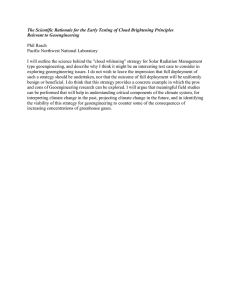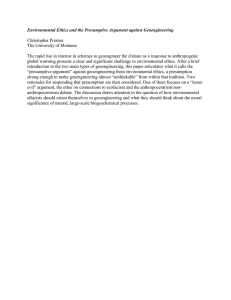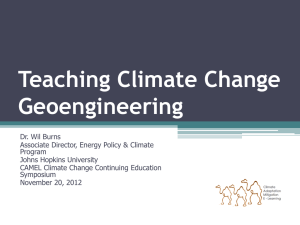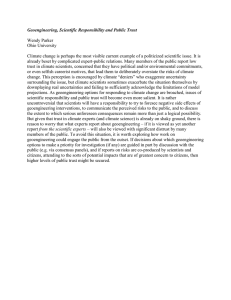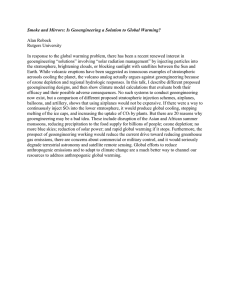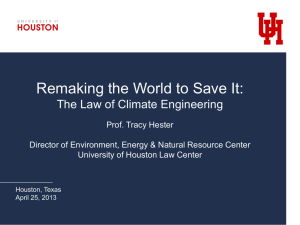Document 11929386
advertisement
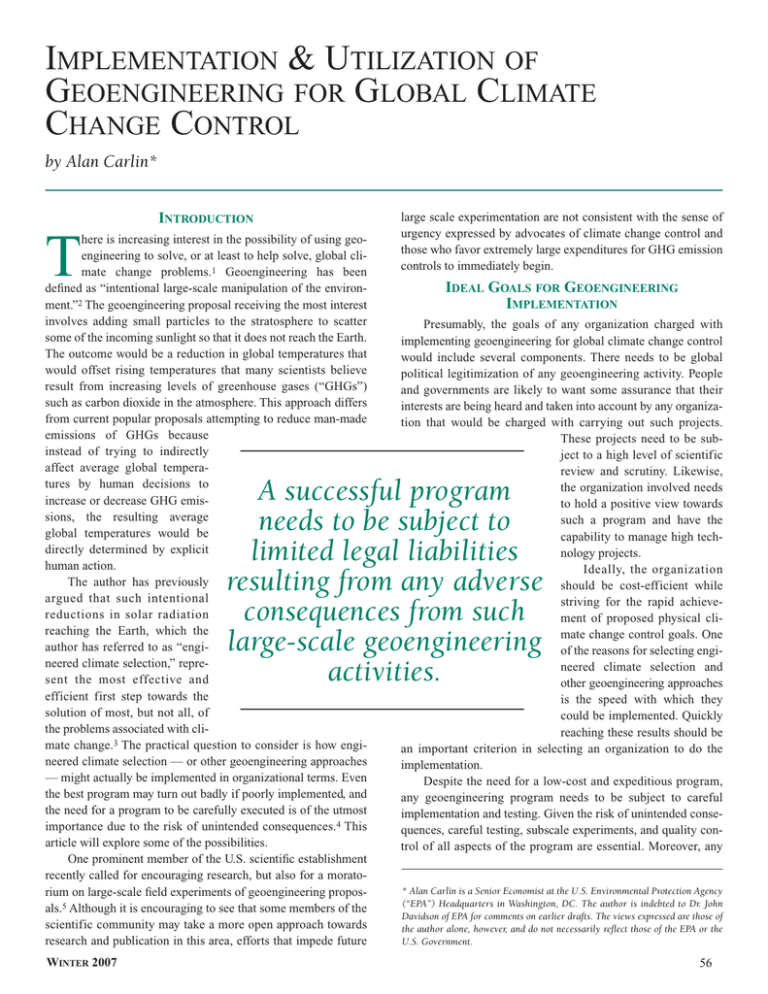
IMPLEMENTATION & UTILIZATION OF GEOENGINEERING FOR GLOBAL CLIMATE CHANGE CONTROL by Alan Carlin* INTRODUCTION here is increasing interest in the possibility of using geoengineering to solve, or at least to help solve, global climate change problems.1 Geoengineering has been defined as “intentional large-scale manipulation of the environment.”2 The geoengineering proposal receiving the most interest involves adding small particles to the stratosphere to scatter some of the incoming sunlight so that it does not reach the Earth. The outcome would be a reduction in global temperatures that would offset rising temperatures that many scientists believe result from increasing levels of greenhouse gases (“GHGs”) such as carbon dioxide in the atmosphere. This approach differs from current popular proposals attempting to reduce man-made emissions of GHGs because instead of trying to indirectly affect average global temperatures by human decisions to increase or decrease GHG emissions, the resulting average global temperatures would be directly determined by explicit human action. The author has previously argued that such intentional reductions in solar radiation reaching the Earth, which the author has referred to as “engineered climate selection,” represent the most effective and efficient first step towards the solution of most, but not all, of the problems associated with climate change.3 The practical question to consider is how engineered climate selection — or other geoengineering approaches — might actually be implemented in organizational terms. Even the best program may turn out badly if poorly implemented, and the need for a program to be carefully executed is of the utmost importance due to the risk of unintended consequences.4 This article will explore some of the possibilities. One prominent member of the U.S. scientific establishment recently called for encouraging research, but also for a moratorium on large-scale field experiments of geoengineering proposals.5 Although it is encouraging to see that some members of the scientific community may take a more open approach towards research and publication in this area, efforts that impede future T large scale experimentation are not consistent with the sense of urgency expressed by advocates of climate change control and those who favor extremely large expenditures for GHG emission controls to immediately begin. IDEAL GOALS FOR GEOENGINEERING IMPLEMENTATION Presumably, the goals of any organization charged with implementing geoengineering for global climate change control would include several components. There needs to be global political legitimization of any geoengineering activity. People and governments are likely to want some assurance that their interests are being heard and taken into account by any organization that would be charged with carrying out such projects. These projects need to be subject to a high level of scientific review and scrutiny. Likewise, the organization involved needs to hold a positive view towards such a program and have the capability to manage high technology projects. Ideally, the organization should be cost-efficient while striving for the rapid achievement of proposed physical climate change control goals. One of the reasons for selecting engineered climate selection and other geoengineering approaches is the speed with which they could be implemented. Quickly reaching these results should be an important criterion in selecting an organization to do the implementation. Despite the need for a low-cost and expeditious program, any geoengineering program needs to be subject to careful implementation and testing. Given the risk of unintended consequences, careful testing, subscale experiments, and quality control of all aspects of the program are essential. Moreover, any A successful program needs to be subject to limited legal liabilities resulting from any adverse consequences from such large-scale geoengineering activities. WINTER 2007 * Alan Carlin is a Senior Economist at the U.S. Environmental Protection Agency (“EPA”) Headquarters in Washington, DC. The author is indebted to Dr. John Davidson of EPA for comments on earlier drafts. The views expressed are those of the author alone, however, and do not necessarily reflect those of the EPA or the U.S. Government. 56 program undertaken needs to have the capability for intermediate course corrections in case important new information becomes available. Although it is well established that at least some technical approaches to engineered climate selection would be effective in controlling global temperatures,6 there are a number of unanswered questions that require research and development.7 Such research may result in the need for midcourse corrections in the implementation program, necessitating a need for organizational capability to make such modifications. A successful program also needs to be subject to limited legal liabilities resulting from any adverse consequences from such large-scale geoengineering activities. It appears likely that any attempt to implement engineered climate selection will result in lawsuits claiming damages for adverse weather conditions allegedly resulting from the project.8 Unless these claims are prohibited in some way or greatly minimized, they could greatly impede the program. IMPLEMENTATION PHASES Any engineered climate selection or other geoengineering program might ideally follow a number of phases; these phases, however, need not be carried out by the same organization: (1) The first phase might be careful laboratory investigation of any critical uncertainties of the program such as trying to verify the lack of significant adverse environmental effects and research on ways to reduce or eliminate them. (2) The second phase might focus on careful real world testing of the proposed engineered climate selection or other geoengineering techniques. After initial modeling of engineered climate selection proposals in (1), scientists might conduct subscale real world experiments at increasing scales to verify remaining uncertainties, leading to development of a detailed plan for final implementation. (3) Gaining acceptance of the plan by legitimizing organization(s) might likely be the third phase. Additionally, incorporating requested appropriate modifications might ensue. (4) The fourth phase might be the plan’s implementation, including revisions to the plan based on new information found after initial approval of the plan. (5) The last phase would presumably consist of maintaining the resulting system after initial implementation. IMPLEMENTATION OPTIONS Most likely the quickest and simplest approach would be for one nation with the needed technical and financial resources to carry out all phases of the project, perhaps with the assistance of contracts to the best qualified aerospace (or possibly other) companies to carry out each phase. The cost would be quite small compared to major military weapon systems and the administrative procedures for such a system’s development are fairly well established in most countries with large military development programs. Finally, the initial implementation could probably be accomplished in a few years’ time if there were no delays caused by non-technical issues. One obvious possibility at the opposite extreme would be for the United Nations (“UN”) to implement such a program. 57 The UN is already deeply involved in climate change issues and has an established organization to deal with them. An intermediate possibility might be an organization of the countries listed in Annex I of the Kyoto Protocol that are interested and willing to make a financial contribution to the effort. One such organization might be the Organization for Economic Co-operation and Development (“OECD”). Another possibility might be the North Atlantic Treaty Organization (“NATO”). Although NATO does not include several of Kyoto’s Annex I nations, it does have experience with large aerospace procurements. Less developed countries (“LDCs”) generally express the view that climate change has been mainly caused by developed countries; thus in their view it is the developed world’s responsibility to solve it. As a result, the choice of an organization representing developed countries would seem appropriate. Presumably only those countries willing to make a financial contribution would be involved so as to minimize the number of players and improve the speed with which decisions could be made. It would also be reasonable for the organization to retain control over all policy issues, but to contract out the actual implementation, presumably on the basis of competitive bidding. COMPARISON OF CHOICE OF ORGANIZATIONS USING CRITERIA Of the three implementation options discussed, the greatest political legitimization would presumably result from using the United Nations to oversee such a project. Restricting the countries involved tends to result in an action appearing less legitimate. In brief, the more countries involved, the stronger the legitimacy. With respect to strong review and scrutiny of a geoengineering project, the UN has built a strong scientific advisory capability in the form of the Intergovernmental Panel on Climate Change, although it is not clear how receptive it would be to geoengineering. The OECD has a tradition of encouraging social science input into its deliberations. Various countries have numerous approaches towards encouraging scientific contributions to their technically related endeavors. However, the criterion of strong scientific review probably does not strongly favor any of the approaches considered here over any of the others. The importance of a positive view towards the program and the capability to manage high technology projects favors a nation, or a small group of nations, managing the project. It is the author’s opinion that the United Nations has been so closely identified with a regulatory emissions reduction approach to global climate change control that one can question whether they would be likely to give geoengineering a fair trial. Additionally, the UN also may not have much experience managing high technology aerospace projects. Rapidly achieving physical climate change control goals is more likely to occur where there are fewer countries involved since fewer voices are likely to result in greater speed in implementing a solution. Though it may jeopardize legitimacy, an individual country, or a small group of countries, running the program would be the quickest option. SUSTAINABLE DEVELOPMENT LAW & POLICY Cost minimization also favors a single country approach. Presumably the more countries there are involved in a program, the higher the cost of deciding what to do. Likewise, there is a greater likelihood that some country or countries will have to be “bought off ” by added expenditures desired by that country. However, because the costs should be modest, this may not be a major consideration. The capability for intermediate course corrections in case of important new information and careful implementation and testing criteria could presumably be achieved in all three organizational approaches. These criteria relate to the structure of the endeavor. Presumably, this capability could be equally well included in all three — although there may be differences between how long they might take to actually implement the plan. Minimizing or handling any resulting legal liabilities for alleged adverse consequences, as discussed elsewhere,9 is likely to be a significant problem with regard to any of the three approaches. Presumably there are ways to set up a geoengineering climate change control program that either minimizes such liability or at least provides for an orderly way to settle such disputes. This is obviously an important area for future legal research. Important questions to consider are: (1) to what extent would the exemption provisions of the U.S. Federal Tort Claims Act apply if the geoengineering were carried out solely by the United States Government; (2) what if alleged damages did not occur in the country of origin; and (3) what are the consequences of other governments or organizations being involved? Once again, an unrefined answer would seem to be that the fewer countries involved, the fewer the complications, but this may be overly simplistic. THE BENEFITS OF LEGITIMIZATION SUPPORT A MULTILATERAL APPROACH A single country approach has many benefits when assessed in relation to a number of the individual criteria. However, in the author’s view these benefits are strongly outweighed for the plan acceptance, implementation, and maintenance phases, and probably for the real world testing as well. Real world testing is already controversial, and is likely to continue to be so even if gradual scaling up and other safeguards are used. A single country approach to anything beyond laboratory testing would likely result in international anger towards the lone country, many lawsuits by groups claiming damages, lack of worldwide public support, and possible lack of support in the country itself. A political consensus would appear to be fundamental to a successful effort in each of these phases. Thus, multilateral options appear to be more likely to succeed. Using the UN or possibly another international organization to oversee such a program might appear somewhat unwieldy and cumbersome, but offers much larger advantages in terms of increased political legitimization. The experience to date, primarily in drafting the Kyoto Protocol, is not particularly encouraging since in order to gain LDC support, the developed nations felt that they had to agree to shoulder the entire bill. This led to a lack of support for the Kyoto Protocol in some countries, mainly WINTER 2007 the United States. One possibility would be for one country to carry out the laboratory research, because no real world experiments or implementation decisions would be made during this phase. In the case of the United States, one observer has suggested the use of an organization modeled on a mini-energy-version of the U.S. Department of Defense’s Advanced Research Projects Agency.10 Increasing interaction with other countries and political legitimization would become even more important as the plan development progressed in order for it to be accepted by other countries. Finally, the actual implementation and maintenance would also be best handled by a politically very legitimate international organization. CONCLUSION If geoengineering represents the most efficient and effective first step towards a solution of the global climate change problem, it is important to analyze how an effective geoengineering effort might best be organized. It would appear that there would be some advantages for any laboratory research to be done by a single country, or perhaps a small group of countries. Overall, international organizations appear to be best situated to handle real world testing, plan acceptance, initial implementation, and maintenance of such a program. Endnotes: Implementation & Utilization of Geoengineering 1 See William J. Broad, How to Cool a Planet (Maybe), N.Y. TIMES, June 27, 2006, at F1, available at http://www.nytimes.com/2006/06/27/science/earth/ 27cool.html?ex=1309060800&en=d0d351a5cf6b48d1&ei=5088&partner=rss nyt&emc=rss (last visited Feb. 10, 2007); P.J. Crutzen, Albedo Enhancement by Stratospheric Sulfur Injections: A Contribution to Resolve a Policy Dilemma?, 77 CLIMACTIC CHANGE 211 (2006); Charles J. Hanley, Could Smog Protect Against Global Warming?, SEATTLE TIMES, Nov. 16, 2006, available at http://seattletimes.nwsource.com/html/nationworld/2003433914_webwarming 16.html (last visited Feb. 15, 2007). 2 David Keith, Geoengineering the Climate: History and Prospect, 25 ANN. REV. ENERGY ENV’T 245 (2000). 3 Alan Carlin, Global Climate Change Control: Is There a Better Strategy than Reducing Greenhouse Gas Emissions?, 155 U. PA. L. REV. (forthcoming June 2007). 4 Carlin, id. at Part VI.D. 5 R. J. Cicerone, Geoengineering: Encouraging Research and Overseeing Implementation, 77 CLIMACTIC CHANGE 221-26 (2006). 6 See Carlin, supra note 3, at Part II.G. 7 See Lowell Wood, Earth Albedo Engineering, Presentation to Energy and Engineering Study Group, Lawrence Livermore National Laboratory, Livermore, CA (Apr. 7, 2005). 8 See Carlin, supra note 3, at Part VI.B. 9 See Carlin, supra note 3, at Part VI.B. 10 LEE LANE, STRATEGIC OPTIONS FOR BUSH ADMINISTRATION CLIMATE POLICY, 90-95 (AEI Press 2006). 58
